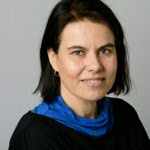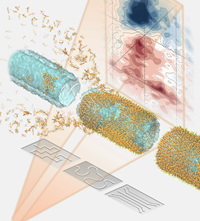Advent calendar - December 24th - Zernike Institute Papers of the Year 2023
In the Zernike Institute Advent Calendar, we are presenting 24 short spotlights in December. In these specials, we highlight PhD students, postdocs, support staff, and technicians of our research groups and team - providing a glimpse into their typical day at work. In Episode 24 - the final one - we are deviating from this and provide our handpicked Best of 2023 publications - the personal research highlights of our principal investigators. These are original research works or reviews authored or co-authored by members of our team. We provide them together with a short summary on what makes the publication a special one. Enjoy the selection, enjoy the science, learn something new, stay curious and most importantly: stay safe, stay healthy, enjoy the holiday season, and all the best for 2024!
The principal investigators are listed in alphabetcial order
Use ctrl+f (Windows)/ cmd+f (Mac) to search for keywords of your interest

Strain Dependent Spin Hall Magnetoresistance in the Multiferroic Antiferromagnet BiFeO3 | D. Sando, S. Chen, O. Paull, B. Xu, J. J. L. van Rijn, C. Xu, S. Xu, F. Appert, J. Juraszek, L. Bellaiche, V. Nagarajan, T. Banerjee | Bismuth ferrite (BiFeO3) is a well known multiferroic oxide and an antiferromagnet and is an interesting playground for investigating the electric field manipulation of magnetism. In this work, along with experimental and theoretical collaborators at FLEET (Australia,New Zealand, USA ), we demonstrate how the two different crystallographic phases in antiferromagnetic BFO manifest as weak ferromagnetic surface states in electrical transport studies, but with distinctly different origin, hitherto unexplored. This work is significant for developing antiferromagnet-based spintronic devices based on BiFeO3 for new computing architectures such as the MESO proposed by Intel. The collaborative interaction for this manuscript was a very enriching experience

Spike-based local synaptic plasticity: a survey of computational models and neuromorphic circuits | Lyes Khacef, Philipp Klein, Matteo Cartiglia, Arianna Rubino, Giacomo Indiveri and Elisabetta Chicca | This paper is special because it provides a framework to look at biologically realistic learning models compatible with CMOS implementations. Furthermore it describes a set of CMOS circuits which constitutes the fundamental building block for constructing these models in hardware.

Nature of Hops, Coordinates, and Detailed Balance for Nonadiabatic Simulations in the Condensed Phase | Maximilian F. S. J. Menger, Qi Ou, Yihan Shao, Shirin Faraji, Joseph E. Subotnik, and D. Vale Cofer-Shabica | In this paper the theoretical chemists at Zernike, in a close collaboration with theoretical chemist from University of Pennsylvania and University of Oklahoma, show the degree of sophistication that can be achieved by our newly developed open-source Interface for Non-Adiabatic Quantum mechanics/molecular mechanics in Solvent (INAQS), which combines a molecular dynamics (MD) code (Gromacs) with an electronic structure software (Q-Chem) enabling various flavors of non-adiabatic dynamics within the QM/MM framework. This novel strategy will enable us to combine the power of the two major software packages and to reliably model photo-induced processes in complex systems. We revisit the ring-opening reaction 1,3-cylohexadiene (CHD) in a solvent environment, by explicitly including the solvent contribution to the nonadiabatic coupling vector─enabling an accurate approach to equilibrium at long times.

A One-Bead-Per-Saccharide (1BPS) Model for Glycosaminoglycans | Saber Shakibi, Patrick Onck and Erik Van der Giessen | The paper describes a methodology for the systematic coarse-graining of polysaccharide compounds. More specifically, it provides a bottom-up model for chondroitin sulfates and hyaluronic acid (HA), starting at the all-atom level up to the point where a complete saccharide ring is represented by a single bead. Despite the enormous coarse graining, the predicted radius of gyration for HA chains of a few hundred kDa agree well with experimental values. This 1BPS model is ideally suited to be used in conjunction with the one-bead-per-amino-acid model previously developed in our group in order to model, for instance, proteoglycans.

Shear Thinning from Bond Orientation in Model Unentangled Bottlebrush Polymer Melts | Utku Gürel and Andrea Giuntoli | The first paper out of the research lines of the new Giuntoli group! In this simulation work we found a relation between the architecture of bottlebrush polymers and their rheological behavior under shear. Fine-tuning of molecular parameters leads to macroscopic control of viscosity which is relevant for many applications, among which 3D-printing.

Quasi-free-standing AA-stacked bilayer graphene induced by calcium intercalation of the graphene-silicon carbide interface | Antonija Grubišić-Čabo, Jimmy C Kotsakidis, Yuefeng Yin, Anton Tadich, Matthew Haldon, Sean Solari, John Riley, Eric Huwald, Kevin M Daniels, Rachael L Myers-Ward, Mark T Edmonds, Nikhil Medhekar, D Kurt Gaskill, Michael S Fuhrer | Two-dimensional materials offer a unique opportunity in terms of allowing easy modification of their properties through various means such as strain, substrate interaction, or intercalation. In this paper, we delve into the intricacies of quasi-freestanding bilayer graphene on silicon carbide (SiC) modified by calcium intercalation. We discovered that calcium intercalation occurs exclusively at the graphene-SiC interface, entirely displacing the hydrogen that terminated SiC. This process induces a notable shift in the system's doping from its original p-doped state to a highly n-doped one. Unexpectedly, our analysis uncovers an electronic structure closely resembling that of AA-stacked bilayer graphene—an unprecedented observation in calcium-intercalated systems. This observation suggests a spontaneous transition from AB- to AA-stacked bilayer graphene subsequent to calcium intercalation at the underlying graphene-SiC interface, a shift facilitated by a slight difference in the formation energy between the two stacking types. This discovery not only unveils a previously unseen transformation in bilayer graphene, but also opens the door to further investigation of this distinct new graphene system with its unique band structure.

Electric control of optically-induced magnetization dynamics in a van der Waals ferromagnetic semiconductor | Freddie Hendriks, Rafael R. Rojas-Lopez, Bert Koopmans, Marcos H. D. Guimaraes | In this work we show how we can control the magnetization dynamics of a 2D magnet using electrostatic gates. We can control the amplitude, frequency and initial phase of the magnetization precession, all by just tuning the voltages in our gate electrodes. We also show the presence and tunability of opto-magnetic effects (e.g. inverse Cotton-Mouton effect) in this 2D magnet. We're now moving forward to exploiting the electrical tunability of magnetization dynamics for magnonic crystals.

Manifestation of hydrogen bonding and exciton delocalization on the absorption and two-dimensional electronic spectra of chlorosomes | Vesna Eric, Xinmeng Li, Lolita Dsouza, Sean K Frehan, Annemarie Huijser, Alfred R Holzwarth, Francesco Buda, GJ Agur Sevink, Huub JM De Groot, Thomas LC Jansen | This paper is the result of a collaboration between our group and the optical spectroscopy group at University of Twente and the NMR group at Leiden University. This study focuses on understanding the molecular origin of disorder in Chlorosomes. Chlorosomes are supramolecular aggregates that contain thousands of bacteriochlorophyll molecules. They perform the most efficient ultrafast excitation energy transfer of all natural light-harvesting complexes. Their broad absorption band optimises light capture. We identified the microscopic sources of the disorder causing the spectral width and revealed how it affects the excited state properties and the optical response of the system. We found that hydrogen bonding motifs are essential for a correct description of the spectral line shape. Furthermore, we find that exciton delocalisation over tens to hundreds of molecules is consistent with the two-dimensional electronic spectra. These lessons will be helpful in the optimising and designing artificial light-harvesting systems as the C8S3 system described in the highlight of the group of Maxim S Pshenichnikov.

Bioinspired Processing: Complex Coacervates as Versatile Inks for 3D Bioprinting | Mohammad Khoonkari, Julien Es Sayed, Marta Oggioni, Armin Amirsadeghi, Peter Dijkstra, Daniele Parisi, Frank Kruyt, Patrick van Rijn, Małgorzata Katarzyna Włodarczyk-Biegun, Marleen Kamperman | In this paper, we developed a new type of biomaterial ink for 3D bioprinting based on a complex coacervate. Complex coacervates are an attractive material class to use as ink, because it starts out as a liquid and transitions into a viscoelastic solid through mild physicochemical changes in the environment.

3D Nanostructuring of Phase‐Change Materials Using Focused Ion Beam Towards Versatile Optoelectronics Applications | Daniel T Yimam, Minpeng Liang, Jianting Ye, Bart J Kooi | Here we propose a new method to create switchable structural colors at the nanoscale in phase-change thin films using focused ion beam patterning. As a proof of principle we reproduced some famous paintings with four million pixels in the thickness of a hair creating real colors that can be switched.

The Role of Thermalization in the Cooling Dynamics of Hot Carrier Solar Cells | T. Faber, L. Filipovic, and L.J.A. Koster | Hot carrier solar cells are the holy grail of photovoltaics (PV), with the potential of radically improved efficiencies (>60%). The central idea of such solar cells is to extract electrons and holes while they are still ‘hot’, i.e. before they loose most of their energy through cooling and relaxation to the band edges. Alas, this cooling process is extremely fast in most semiconductors, as this tends to occur on the ps timescale. In order to make hot-carrier PV reality, absorber materials with unusually long carrier cooling times thus are required. Metal halide perovskites are such materials, but their cooling times and the cooling mechanisms remain the subject of much debate and research. In order to shed some light on this issue, we resort to Monte-Carlo simulations of the cooling process and provide important pointers for improved materials.

Antiferromagnetism-driven two-dimensional topological nodal-point superconductivity | Maciej Bazarnik, Roberto Lo Conte, Eric Mascot, Kirsten von Bergmann, Dirk K. Morr & Roland Wiesendanger | Magnet-superconductor hybrid materials are man-made materials where we can understand and engineer the interplay of magnetism and superconductivity. Such interplay is expected to give origin to emergent quantum properties, such as topological superconductivity, which can play a crucial role in the design of novel quantum technologies. In this manuscript it was shown, for the first time, the emergence of a topological superconducting state driven by the interaction of a two-dimensional antiferromagnetic layer with a conventional superconductor. The emergent unconventional superconductivity was directly observed, at the atomic scale, via low-temperature scanning tunneling microscopy and spectroscopy. This work establishes the interplay of superconductivity and antiferromagnetism as a valuable pathway towards the development of new topological materials.

Approaching Bulk Mobility in PbSe Colloidal Quantum Dots 3D Superlattices | Jacopo Pinna, Razieh Mehrabi Koushki, Dnyaneshwar S Gavhane, Majid Ahmadi, Suhas Mutalik, Muhammad Zohaib, Loredana Protesescu, Bart J Kooi, Giuseppe Portale, Maria Antonietta Loi | 3D superlattices made of colloidal quantum dots are a promising candidate for the next generation of optoelectronic devices as they are expected to exhibit a unique combination of tunable optical properties and coherent electrical transport through minibands. While most of the previous work was performed on 2D arrays, the control over the formation of these systems is lacking, where limited long‐range order and energetical disorder have so far hindered the potential of these metamaterials, giving rise to disappointing transport properties. Here, it is reported that nanoscale‐level controlled ordering of colloidal quantum dots in 3D and over large areas allows the achievement of outstanding transport properties.
In situ SnSe deposition as passivation for scalable and stable quasi-2D lead–tin perovskite solar cells | Lijun Chen, Eelco Kinsa Tekelenburg, Kushagra Gahlot, Matteo Pitaro, Jun Xi, Alessia Lasorsa, Giovanna Feraco, Loredana Protesescu, Patrick C. A. van der Wel, Giuseppe Portale, Petra Rudolf, Christoph J. Brabec and Maria Antonietta Loi | The road towards commercialization of perovskite solar cells requires efforts towards improving device stability and developing scalable deposition techniques. Lead–tin (Pb–Sn) alloys show great potential for single-junction and all-perovskite tandem solar cells due to their narrower bandgap and reduced toxicity but suffer from inferior stability. Ruddlesden–Popper (RP) perovskites have demonstrated superior stability and enhanced crystallization with respect to 3D compositions. However, quasi-2D RP Pb–Sn devices are rarely reported, especially deposited with scalable techniques, where the state-of-the-art PCE is only about 10%. Here, we demonstrate for the first time a nominal composition PEA 2 (FA 0.5 MA0.5 ) 4 (Pb 0.5 Sn0.5 )5 I 16 (n = 5) with a gradient structure deposited by a two-step blade coating. Moreover, a thin passivation layer of SnSe is obtained from the in situ reaction of SnAc 2 and DMS on the perovskite surface, which significantly reduces nonradiative recombination and enhanced surface quality. As a result, the output voltage and fill factor of solar cells are significantly improved. In addition, the hydrophobic SnSe also significantly protects the active layer from the environment. This work paves the way for in situ passivation strategies and the development of stable, scalable, and environmentally friendly perovskite devices.

Lightweight Triboelectric Nanogenerators Based on Hollow Stellate Cellulose Films Derived from Juncus effusus L. Aerenchyma | Chen, Q.; Li, W. J.; Yan, F.; Maniar, D.; van Dijken, J.; Rudolf, P.; Pei, Y. T.; Loos, K. | We have developed flexible and lightweight triboelectric nanogenerators (HSC-TENGs) from wetland weed Juncus effusus L., achieving a very high output voltage by manipulating the triboelectric polarities through silanization and incorporating Ag nanowire electrodes. These innovative HSC-TENGs, featuring both macro-scale surface roughness and micro-nano inner pores, not only outperform traditional counterparts but also find application as self-powered sensors for gait analysis, showcasing their potential in multifunctional cellulose-based technologies. This work is a cooperation of various ZIAM groups with ENTEG.

Biobased 2,5-Bis(hydroxymethyl)furan as a Versatile Building Block for Sustainable Polymeric Materials | Cornelis Post, Dina Maniar, Vincent S. D. Voet, Rudy Folkersma, and Katja Loos | Furanic polymers, such as PEF (polyethylene furanoate), hold significant promise for replacing fossil fuel-derived plastics. While extensive research has centered on PEF's precursor, FDCA, and related substances, relatively little attention has been directed toward BHMF (2,5-bis(hydroxymethyl)furan). This review paper aims to bridge this gap by comprehensively examining the study of BHMF-based polymers, focusing primarily on their synthesis methods, potential applications, and the overall (bio)degradability of furan polyesters.

Magnetization reversal through an antiferromagnetic state | Somnath Ghara, Evgenii Barts, Kirill Vasin, Dmytro Kamenskyi, Lilian Prodan, Vladimir Tsurkan, István Kézsmárki, Maxim Mostovoy & Joachim Deisenhofer | In the Nature Communications paper we explained sharp electric polarization peaks at the magnetization reversals, observed by experimentalists from the Augsburg University in the Zn-doped kamiokite. We related the peaks to the competing antiferromagnetic phase that surprisingly intervenes when the magnetization changes sign.

Lessons from hafnium dioxide-based ferroelectrics | Beatriz Noheda, Pavan Nukala & Mónica Acuautla | A bit more than a decade after the first report of ferroelectric switching in hafnium dioxide-based ultrathin layers, this family of materials continues to elicit interest. There is ample consensus that the observed switching does not obey the same mechanisms present in most other ferroelectrics, but its exact nature is still under debate. This is a perspective article in which we show that, despite our incomplete understanding, the lessons learned from hafnium dioxide-based ferroelectrics offer interesting avenues beyond ferroelectric random-access memories and field-effect transistors, which may enable low-power electronics, self-powered devices and energy-efficient information processing.

Phase separation of intrinsically disordered FG-Nups is driven by highly dynamic FG motifs | Maurice Dekker, Erik Van der Giessen, and Patrick R. Onck | In recent years, phase separation of intrinsically-disordered proteins (IDPs) has been recognized to be a powerful mechanism of cells to organize their cytoplasm and nucleoplasm. The phase state of the disordered FG-Nups that guard the selective permeability barrier of the nuclear pore complex is unknown and under intense debate. In this paper we show, for the first time, that more than half of the FG-Nups form liquid-like condensates, elucidating distinct functional roles of two classes of FG-Nups in establishing the pore’s selective barrier.

Watching Molecular Nanotubes Self-Assemble in Real Time | Marìck Manrho, Sundar Raj Krishnaswamy, Björn Kriete, Ilias Patmanidis, Alex H. de Vries, Siewert J. Marrink, Thomas L. C. Jansen, Jasper Knoester, and Maxim S. Pshenichnikov | Molecular self-assembly is one of the pillars in the fabrication of functional (bio)chemical systems, with examples in a wide variety of materials and biological systems, ranging from liquid crystals and photoactive dye aggregates to photosynthetic light-harvesting complexes and protein based materials.

Understanding the mechanisms that govern the self-assembling process in such systems from the individual molecules, through small individual sub-units all the way up to the complete assembly is vital to unravel nature’s highly successful design principles and learn how to exploit those for developing new functional materials. Here we used microfluidics, cryo-TEM imaging, ultrafast correlation spectroscopy, and linear dichroism spectroscopy to obtain real-time information on the self-assembly process. This was complemented by molecular dynamics simulations and exciton modelling, which allowed us to reveal a detailed picture of the self-assembly processes from individual molecules to the supramolecular structure.

Real-time structural characterization of isotactic polypropylene during cast film extrusion | Federico Di Sacco, Eduardo Solano, Marc Malfois, Jingbo Wang, Markus Gahleitner, Roberto Pantani, Giuseppe Portale | This publication shows for the first time that a complicated industrial process in plastic industry such as cast film extrusion can be followed in-situ and in-real time using synchrotron X-ray analysis. Tracking plastic processing in real time during processing helps academics and companies to lay important steps towards future efficient monomaterial packagings, increasing plastic recycling opportunities.

Nickel Boride (NixB) Nanocrystals: From Solid-State Synthesis to Highly Colloidally Stable Inks | Jennifer Hong, Suhas Mutalik, Matteo Miola, Dominic Gerlach, Razieh Mehrabi K., Majid Ahmadi, Bart J. Kooi, Giuseppe Portale, Petra Rudolf, Paolo P. Pescarmona, and Loredana Protesescu | Metal borides, widely used in industry for various applications, are underexplored at the nanoscale due to synthesis challenges. We present a novel solid-state method for synthesizing nickel boride (NixB) nanopowders and converting them into colloidal suspensions. Using commercially available salts, we obtained pure phase Ni3B and Ni2B nanocrystals under mild, solvent-free conditions. Mechanistic studies revealed Ni nanoclusters as intermediates, and size control was achieved through reaction mediators. Surface engineering with inorganic or organic ligands produced stable inks for further applications. Our approach opens avenues for developing NixB-based catalysts and other metal boride nanostructures.

Lateral membrane organization as target of an antimicrobial peptidomimetic compound | Adéla Melcrová, Sourav Maity, Josef Melcr, Niels A. W. de Kok, Mariella Gabler, Jonne van der Eyden, Wenche Stensen, John S. M. Svendsen, Arnold J. M. Driessen, Siewert J. Marrink, Wouter H. Roos | In this paper we study the mode of action of an synthetic antibiotic using high speed atomic force microscopy (HS-AFM). This approach shows in real-time how the antibiotic attacks the bacterial membrane and thereby we were able to reveal, at the single particle level, the mode of action of this antimicrobial compound.

New insights in polydopamine formation via surface adsorption | Hamoon Hemmatpour, Oreste De Luca, Dominic Crestani, Marc C. A. Stuart, Alessia Lasorsa, Patrick C. A. van der Wel, Katja Loos, Theodosis Giousis, Vahid Haddadi-Asl, Petra Rudolf | Polydopamine coatings show great promise: they don’t require any solvents other than water, and are biocompatible. They are versatile coatings that adhere to almost all surfaces. These coatings form very quickly, too fast to study intermediates that might reveal what is happening. We therefore used nanosized tubes from a clay mineral as substrate for the coating. The large surface area and negative charges in the mineral attract intermediates from the solution, thereby slowing down the polymerization process. This allowed us to take samples of the nanotubes during the polymerization process to identify the intermediates using nuclear magnetic resonance and X-ray photoelectron spectroscopy.

An X-ray spectroscopy study of structural stability of superhydrogenated pyrene derivatives |Yining Huo, Mónica K Espinoza Cangahuala, Vicente Zamudio-Bayer, Marcelo Goulart, Markus Kubin, Martin Timm, J Tobias Lau, Bernd von Issendorff, Ronnie Hoekstra, Shirin Faraji, Thomas Schlathölter | For many years, our group and the Stockholm group of Henning Zettergren/Henrik Cederquist have studied the influence of hydrogen attachment on the structural resilience of polycyclic aromatic hydrocarbons (PAHs). While we have observed protection of the backbone of coronene molecules, the Stockholm group have observed the opposite for smaller pyrene-based PAHs. In this article, for the first time we have performed a direct comparison. We have spectroscopically studied X-ray induced ionization and fragmentation of both coronene and pyrene and their hydrogenated counterparts in one experimental setup and compared the results to quantum chemical calculations. We found that PAH size is a key factor for the molecular response, which large PAHs being stabilized and small PAHs being weakened by H attachment. This has important consequences for the abundance of PAHs in astronomical environments.

Analogs of Rashba-Edelstein effect from density functional theory | Karma Tenzin, Arunesh Roy, Homayoun Jafari, Bruno Banas, Frank T. Cerasoli, Mihir Date, Anooja Jayaraj, Marco Buongiorno Nardelli, and Jagoda Sławińska | Converting spin signals into electric currents and vice versa is crucial for spintronics devices. In this study, we show that the known conversion mechanism, the Rashba-Edelstein effect, commonly associated with the so-called Rashba materials that host Rashba spin texture, can occur in a broader class of materials. In fact, crystals possessing Dresselhaus or Weyl spin texture, or even more peculiar spin patterns may also manifest the Rashba-Edelstein effect occurring in conventional and unconventional configurations. Our study overviews the link between the spin textures and geometry of the Rashba-Edelstein effect and is complemented by the group theory analysis performed for all 230 crystallographic space groups. The knowledge of allowed geometries based only on the crystal symmetry is invaluable for the design of devices.

Spectroscopic Manifestations and Implications for Catalysis of Quasi-d10 Configurations in Formal Gold(III) Complexes | Trifonova, E. A., Leach, I. F., de Haas, W. B., Havenith, R. W. A., Tromp, M. & Klein, J. E. M. N. | Collaborative project between ZIAM and Stratingh, via RUG Scholarship student I. Leach, using a combination of spectroscopy and theory to rediscuss fundamental concepts like oxidation state, molecular orbital occupancy, charge transfer, etc and it's implications for catalysis.

Magnetic field control of light-induced spin accumulation in monolayer MoSe2 | Rafael R. Rojas-Lopez, Freddie Hendriks, Caspar H. van der Wal, Paulo S. S. Guimarães, Marcos H. D. Guimaraes | This paper reports work from a collaboration that looked into the behaviour of atomically-thin two-dimensional semiconductors, that were discovered in recent years. The starting point was the well-understood physics of how absorption of light (with a certain optical polarization) can result in charge carriers that are spin polarized. However, this spin polarization typically disappears again very fast, as soon as the system has its optical relaxation. We showed how applying a magnetic field (or interaction with another material) can influence the relaxation dynamics, and strongly lengthen the lifetime of the spin polarization. This work is of interest for developing spintronic and sensor applications with low-power and compact nanodevices.

Anomalous peroxidase activity of cytochrome c is the primary pathogenic target in Barth syndrome | Valerian E. Kagan, Yulia Y. Tyurina, Karolina Mikulska-Ruminska, Deena Damschroder, Eduardo Vieira Neto, Alessia Lasorsa, Alexander A. Kapralov, Vladimir A. Tyurin, Andrew A. Amoscato, Svetlana N. Samovich, Austin B. Souryavong, Haider H. Dar, Abu Ramim, Zhuqing Liang, Pablo Lazcano, Jiajia Ji, Michael W. Schmidtke, Kirill Kiselyov, Aybike Korkmaz, Georgy K. Vladimirov, Margarita A. Artyukhova, Pushpa Rampratap, Laura K. Cole, Ammanamanchi Niyatie, Emma-Kate Baker, Jim Peterson, Grant M. Hatch, Jeffrey Atkinson, Jerry Vockley, Bernhard Kühn, Robert Wessells, Patrick C. A. van der Wel, Ivet Bahar, Hülya Bayir & Miriam L. Greenberg | This paper is the product of a long-term collaboration with an international team of researchers. It is nice in many ways. One nice aspect is that we were able to use our NMR spectroscopy to study the dynamics of a disease-related protein-lipid complex, and even see how that complex can be targeted with a drug-like compound. We hope this paves the way for a better understanding of Barth syndrome and may even inform the design of new treatments.

Long-distance magnon transport in the van der Waals antiferromagnet CrPS4 | Dennis K. de Wal, Arnaud Iwens, Tian Liu, Ping Tang, Gerrit E. W. Bauer, and Bart J. van Wees | This is the first demonstration that transport of spin information from an injector to a detector can also take place in layered van der Waals antiferromagnetic materials. Antiferromagnetic materials have no net magnetization, but we have shown that they can nevertheless efficiently transfer spin information.

Smart and sustainable: Exploring the future of PHAs biopolymers for 3D printing in tissue engineering | Joanna Żur-Pińska, Magdalena Z. Gładysz, Didi Ubels, Jeroen Siebring, Małgorzata K. Włodarczyk-Biegun | It is a review paper that includes some of our early-stage experimental results of 3D printing of PHAs. The paper is a result of our collaboration with Hanze and Silesian University of Technology. It is focused on the Polyhydroxyalkanoates-based inks as new sustainable materials for printing. We summarize state-of-the art research on PHAs printing using different techniques and propose future directions, including our pioneering work on PHAs melt-electrowriting and producing scaffolds for tissue engineering that can be degraded on-demand. And all in an environmentally-friendly way!

Orbital Fulde–Ferrell–Larkin–Ovchinnikov state in an Ising superconductor | Puhua Wan, Oleksandr Zheliuk, Noah F. Q. Yuan, Xiaoli Peng, Le Zhang, Minpeng Liang, Uli Zeitler, Steffen Wiedmann, Nigel E. Hussey, Thomas T. M. Palstra & Jianting Ye | In a ground-breaking experiment, scientists from the University of Groningen, together with colleagues from the Dutch universities of Nijmegen and Twente and the Harbin Institute of Technology (China), have discovered the existence of a superconductive state that was first predicted in 2017. They present evidence for a special variant of the FFLO superconductive state. This discovery could have significant applications, particularly in the field of superconducting electronics.
| Last modified: | 22 December 2023 07.51 a.m. |
More news
-
16 April 2024
UG signs Barcelona Declaration on Open Research Information
In a significant stride toward advancing responsible research assessment and open science, the University of Groningen has officially signed the Barcelona Declaration on Open Research Information.
-
02 April 2024
Flying on wood dust
Every two weeks, UG Makers puts the spotlight on a researcher who has created something tangible, ranging from homemade measuring equipment for academic research to small or larger products that can change our daily lives. That is how UG...
-
18 March 2024
VentureLab North helps researchers to develop succesful startups
It has happened to many researchers. While working, you suddenly ask yourself: would this not be incredibly useful for people outside of my own research discipline? There are many ways to share the results of your research. For example, think of a...
